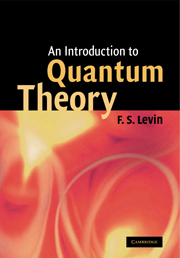Book contents
- Frontmatter
- Contents
- Preface
- PART I INTRODUCTORY
- Chapter 1 The Need for a Non-Classical Description of Microscopic Phenomena
- Chapter 2 Classical Concepts and Quantal Inequivalences
- Chapter 3 Introducing Quantum Mechanics: A Comparison of the Classical Stretched String and the Quantal Box
- Chapter 4 Mathematical Background
- PART II THE CENTRAL CONCEPTS
- PART III SYSTEMS WITH FEW DEGREES OF FREEDOM
- PART IV COMPLEX SYSTEMS
- Appendix A Elements of Probability Theory
- Appendix B Fourier Series and Integrals
- Appendix C Solution of Legendre's Equation
- Appendix D Fundamental and Derived Quantities: Conversion Factors
- References
- Index
Chapter 1 - The Need for a Non-Classical Description of Microscopic Phenomena
Published online by Cambridge University Press: 05 June 2012
- Frontmatter
- Contents
- Preface
- PART I INTRODUCTORY
- Chapter 1 The Need for a Non-Classical Description of Microscopic Phenomena
- Chapter 2 Classical Concepts and Quantal Inequivalences
- Chapter 3 Introducing Quantum Mechanics: A Comparison of the Classical Stretched String and the Quantal Box
- Chapter 4 Mathematical Background
- PART II THE CENTRAL CONCEPTS
- PART III SYSTEMS WITH FEW DEGREES OF FREEDOM
- PART IV COMPLEX SYSTEMS
- Appendix A Elements of Probability Theory
- Appendix B Fourier Series and Integrals
- Appendix C Solution of Legendre's Equation
- Appendix D Fundamental and Derived Quantities: Conversion Factors
- References
- Index
Summary
Quantum mechanics is the theoretical framework that describes physical phenomena on the microscopic scale. In particular, it is used in those situations in which Planck's constant h, approximately equal to 6.62 × 10-34 Js, cannot be assumed to be negligible, despite its apparently tiny magnitude. Macroscopic phenomena, on the other hand, involve magnitudes that are so large that h can be set equal to zero without appreciable error.
As an illustration of this in the macroscopic context, consider the following example: a ladybug (Hippodamia convergens) of mass 1 g moves radially at a speed of 0.01 ms-1 on a turntable rotating at 10 rpm. In the rotating frame of reference, the ladybug has a kinetic energy of about an erg, and, in the laboratory frame, its angular momentum is roughly 10-5 Js when it is at a distance of 0.1 m from the center of the rotating turntable. The latter angular momentum is of the order of 1028h. Thus, relative to this value, h is well approximated by zero and, indeed, only classical mechanics is needed to describe the ladybug's motion.
In contrast to the preceding example, an electron in the “2p” level of hydrogen has an energy of about 10-25 J and an angular momentum whose magnitude is approximately h/(2π) = ħ (pronounced “h-bar”). Here, h cannot be ignored and only a quantum description can accurately account for the properties of this system.
- Type
- Chapter
- Information
- An Introduction to Quantum Theory , pp. 3 - 26Publisher: Cambridge University PressPrint publication year: 2001



